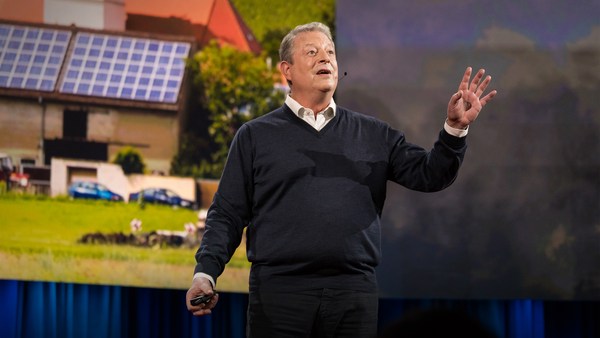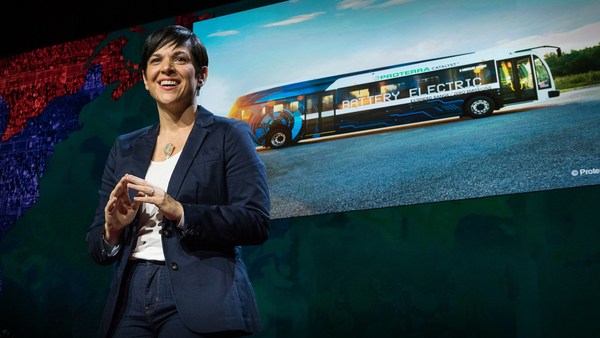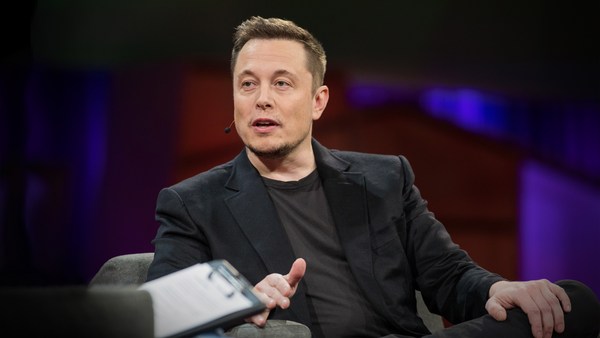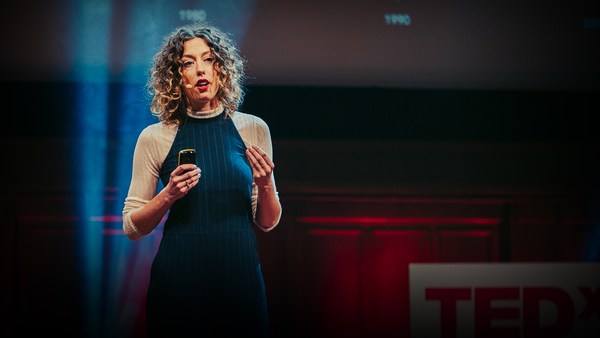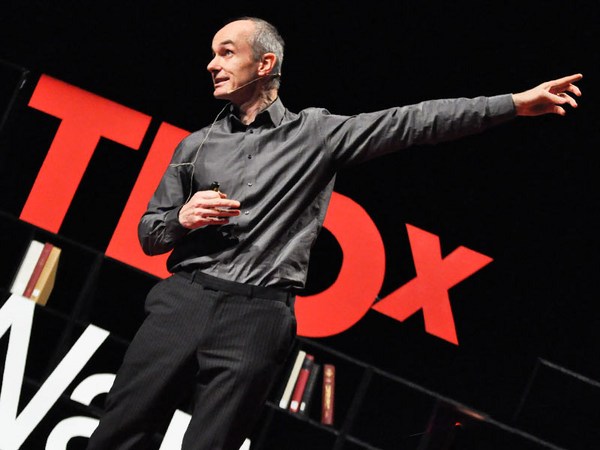There's something really incredible happening. So there's over a billion people who have no access to energy whatsoever across the world, 620 million of them here in Africa. It costs about 1,500 dollars to connect each household up to the grid. If you are going to wait for it, it takes about nine years, on average, and that feels like a lifetime when you're trying to make that happen. That's kind of unbelievable, and it's also unacceptable. So let's do something about it.
The lightbulb comes from this idea that you have an energy system that's made up of the ideas of Tesla and the ideas of Thomas Edison. There was an evolution that said it's not just about the lightbulb, it's about the whole system, the whole energy system that goes with that lightbulb, and what happened in that gilded age was the creation of an industrial system that every country around the world has now started to emulate. So to get to the appliances, you need to have power stations. From power stations, you need to have infrastructure, and that infrastructure takes you to the point of having electricity, and you get to the lightbulbs and the appliances that we all take for granted.
But the amazing thing, in a way, is that there's a revolution happening in the villages and towns all around us here in East Africa. And the revolution is an echo of the cell phone revolution. It's wireless, and that revolution is about solar and it's about distributed solar. Photons are wireless, they fall on every rooftop, and they generate enough power to be sufficient for every household need.
So that's an incredible thing. There's also a problem with it. Up until now, the technology hasn't been there to make it happen, and the mindset has been that we have to have the grid to provide industrial growth and let countries develop and create jobs and industrialize. So we've gotten ourselves to the point where actually the costs of building these grids and following that pattern of development are really unsustainable. If you add up the deficits that all of the utilities run in Africa, sub-Saharan Africa, you get to a number of 21 billion dollars every year to maintain that system and keep it going. So an extraordinary amount of resources that's been put in to creating a system that ultimately we will have to wait a very long time for, and when it comes, it often doesn't come with sufficient robustness to allow us to go down that path to development. So what a shame.
But here's what's happening, and here's the opportunity that I think we should all get excited about. So there's a group of companies that have been chipping away at this problem over the last 10 years, and this group of companies have recognized the reality that there's a great big nuclear reactor up there in the sky, and that Africa is more endowed with that solar power that comes from the sky, the sun, than almost any other continent. So the opportunity has come to convert some of that solar power, wireless power, into energy at the household level.
And three things have happened at the same time. First, the costs of solar productivity have come down. So putting a panel on your roof and generating power from it, that cost has absolutely collapsed over the last 30 years, and it's gone down by 95 percent.
Second, the appliance network. So the group of appliances that we've all gotten used to, we all want and we all need, we all see as part of our everyday lives that give us health and security, those appliances have come down in cost. So if you take the LED lightbulb, for example, a very simple thing, they're now 85 percent less than they were five years ago, and their efficiency, when you compare them to an incandescent bulb, like the lightbulb I showed in the previous slide, is incredible. They give you 10 times the amount of light, and they last 30 times as long.
And then the last thing that's happened is of course the cell phone revolution, so we're piggybacking off the cell phone revolution, and we can now make decentralized customers make small payments for bits of equipment and appliances where actually they're now affordable. We can pay them off over a daily or a weekly schedule. So this is an incredible change in the economy that's happening, and it's really opened up something very, very innovative.
So I'm going to introduce you to a lady I met with last week. Her name's Susan. It may not look like it, but Susan is a representative of a $27 billion market. 27 billion dollars is what people like Susan spend every year on cell phone charging, flashlight batteries and kerosene to light their homes. So Susan is a proud owner of a small solar system. It's a kit rather than a planetary thing, so a small solar system, and her small solar system allows her to have a couple of lightbulbs, and she's made this transition, this jump, from kerosene into light. She has four or five lights and a radio. It's fantastic, and she talks about it. She talks about her kids doing homework at night because she has light. I'm not sure what the kids feel about that. She talks about the fact that she can go out at 4am and look after the cows, and she's not so worried, but also, with a little twinkle in her eye, she talks about how light turns her house into a home at night. She's not scared of her own house at night, because it has light in it, and I thought that was amazing.
So Susan does something that many customers of these companies that I talked about do, and she forces us to innovate. She challenges companies, saying, "I've got the radio and the lights. You know what? I'd like a TV. I'd like to entertain, educate me and my kids. And then I would like to have some hair clippers for my kids, you know, to cut my kids' hair, and I'd love to have a fridge. And she's coined something that the energy world is really hungry to do. The idea that she's coined is the energy ladder. It starts, again, with a lightbulb. Right? And the lightbulb is an idea that we can get our kids to do homework, and very cheap, about five dollars, and we can get it distributed. But then let's go up from there. This is the kit that Susan has: four lightbulbs, radio, maybe a little flashlight, a little solar panel on the roof. And then let's go up again. We can get maybe at about 500 dollars, the previous kit was maybe $150, again, paid for over time, two years to pay it all off, you can get the TV, so the lightbulbs and the TV.
And you start to ask yourself, "So where is this headed?" Is this headed here, where we can have distributed systems with the right infrastructure to provide power for our hospitals and our schools? And really how far can this go? And this is the mindset shift that I think is really exciting. How far can we go? Could it get up to here? You know, this is the conceptual design for one of the world's biggest factories, designed to be fully solar-powered and fully off grid. Maybe we can get that.
So there's a generation of these companies that are out there doing this work and creating thousands of jobs, creating, selling, tens of thousands of these solar systems, so bringing tens of thousands of families into light, and tackling that big $1 billion problem that I talked about at the beginning, and really innovating. And what they're doing is, they're not only energy companies, they're also credit finance companies, so they're bringing people into an economy. They're retail companies, so they're taking products out to people in the connecting markets. And they're appliance companies, so they're developing extraordinary products that are very efficient and very cheap.
So an extraordinary thing is happening out there that's worth recognizing. And where does it take us? From a governmental perspective, from a social perspective, it takes us out to two really big goals. We aspire towards energy access for everybody, and we aspire towards a fully-functioning low-carbon economy. And we're getting to the point where we're seeing the fully-functioning low-carbon economy is not just about getting people onto the grid, it's about getting people onto electricity and doing it in a way that's really dignified.
So I want us all to picture it for a moment, really picture what this could mean: [New energy ecosystem] an energy system that's not just about subsistence power, getting the family off the kerosene, but it's actually the full suite of appliances and tools and productivity that we've all gotten used to, so actually energy at a scale that can drive industrial development. And it's the ability to have powerful tools. It's the ability to be productive in the households, as a farmer, or as a carpenter or as a tailor and get your businesses to work and bring you into the economy.
And I was working again a couple of days ago with a farmer just outside of Nairobi, small field, and he has an irrigation pump that's run off solar, and he was bragging about how much of a difference it made to his productivity. When we were listening to him, we were asking ourselves, at what point will it be that actually, you will be charging an electric scooter off your rooftop and taking your crops to market with mobility that you've charged yourself, using your own power? And that's an extraordinary thing that's happening, and if you listen to Susan and Francis, you get to this point where you say, "These guys have this extraordinary sense of dignity about the way they're achieving their power, the sense of ownership and the sense of pride, and I'm going to flip into a little tiny video clip, which is from a distributor of one of these companies that I'm talking about. And he puts it better than anyone I've ever heard it. So just listen to this.
Martin: So if it does happen that we get to a point where every home has their own independent supply of energy, that will give us the democracy of energy. That's it. And everybody has that choice, and everybody knows when they want to switch it on or off, whether they want to sell access or whether they want to store it. That freedom getting back into the hands of the consumer, that would be the most exciting thing.
Amar Inamdar: Brilliant, right? That was Martin, and he has a really wonderful turn of phrase, and what a sense of vision that he captures.
So picture that for a moment: every household a proud producer as well as consumer of energy ... the ability to generate power, to share power, to sell power, all coming from your own generating asset sitting on your own property. Maybe even think about crowdsourcing with your neighbors the grid from the ground up, rather than waiting for the government to bring it from the top down.
So in Africa, we have this extraordinary opportunity right now, an extraordinary opportunity, to change the world and create an energy system that everybody will be jealous of, and everybody will look to us as the innovators of. And that's the democracy of energy.
Thank you very much.
(Applause)
Chris Anderson: Quick question. So it's a really exciting vision. Help us understand, what are the key roadblocks right now? Like, what could make this go faster?
AI: So the first one, I think, is really the intermittency of solar power. So the problem is that the sun only shines for 12 hours a day, so you've got darkness for 12 hours a day, and we need to have storage solutions that are better to help us take us down that path. So storage is really one.
CA: And those prices are coming down.
AI: And those prices are coming down very quickly. Second, the appliance set. So it needs to get more efficient, and it needs to get more diverse. We need to do more of the things we in Africa want to do with the appliance set.
CA: DC appliances.
AI: DC appliances, and I think there's a real opportunity there, Chris. I think the opportunity is that we could shift some of these 21 billion dollars of subsidies that governments are spending on the current electricity system and we could promote R&D here in Africa to create some of these products, to be some of these entrepreneurs, and make this happen. So create this new system here.
CA: And some of the companies themselves, I mean, there's plenty of demand there. What's holding them back from supplying that demand? I mean, some of them talk about, they would like to sell 10x what they can currently sell.
AI: Exactly. So for many of these capitals, it's that markets don't price consumer risk very well, and particularly in markets like ours, in emerging markets and here in Africa. So there's not enough working capital coming into this space because the big financiers look at this space and say, "I don't know how to price that risk, so I'm going to stay away from it." And that's holding a lot of these companies back.
CA: Well, it's incredibly exciting to picture what could happen here. In my mind, this might be the biggest leapfrog of them all. And thank you for all you're doing and for sharing that vision so powerfully.
